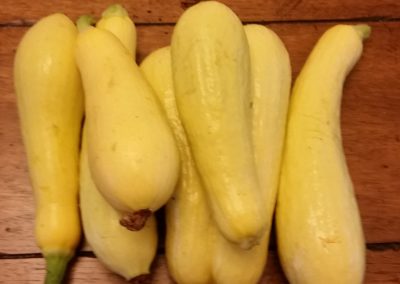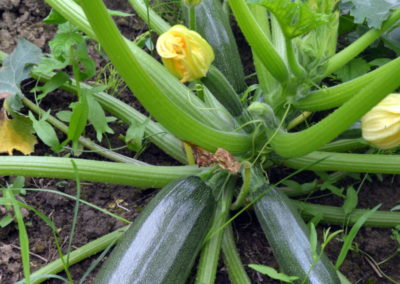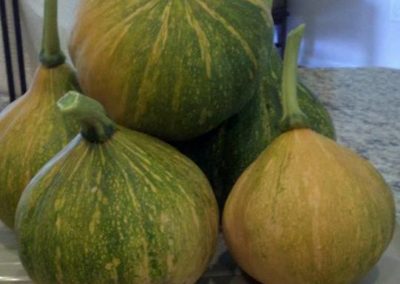In Florida we plant out summer squash (yellow squash, zucchini) Feb. – March and Aug. – Sept. Winter squash (pumpkin, butternut) Feb. – March and Aug. *See Planting Guide for more specific dates for your location
How to Grow: Culture of squash and pumpkins is similar to that of cantaloupe and cucumber, which are also members of the squash family. Squash and pumpkins require warm days and warm nights to mature properly. Sow seeds 1/2 to 1 in. deep. Bush varieties should be spaced 18-30 in. apart in rows 4 ft. apart, or 6-8 seeds per hill, in hills 4 ft. apart. Vining varieties are planted in rows or hills 6-8′ apart. Keep soil moisture high by mulching.
Seed Watering Notes: Be careful not to overwater germinating seeds or they may rot. It’s best to soak the ground or the potting soil heavily when first planting, then avoid watering again if possible until seedlings emerge. (For seeds in potting soil, keep them warm but out of direct sunlight so that they don’t dry out so fast.) Cucumber seeds emerge in 5+ days; very lightly water ground or potting soil around day 3 or 4 to keep soil from crusting so that seeds can emerge more easily.
Transplants: Sow seeds 1/2 in. deep, 2-3 seeds per pot. Cut off weak seedlings at the base to avoid disturbing roots. Seeds germinate best at 85-90 degrees F (29-32 degrees C). Maintain seedlings at 75 degrees F or higher. Harden plants before setting out, and take care not to disturb fragile roots when transplanting. Since cucumber transplants are fussy, hold back a few seedlings for filling in any gaps in the row as they appear.
Fruit Set: Flowers may not set fruit in exceptionally hot weather. Plant out winter squash early enough so that fruit will already be forming when high heat arrives.
Harvesting Summer Squash: Harvest yellow squash and zucchini when 4-6 in. long. Zucchinis will grow large enough to become “attack zucchinis” if you don’t keep them harvested. Yellow squash are the easiest to find when harvesting!
Harvesting Winter Squash (and Pumpkins): Winter squash is ready for harvest when the rind loses its shiny luster, becomes duller, can no longer be dented by a fingernail, and when stems have dried. Harvest by cutting stems 1 in. above the fruit (leave stems on, squash will store better). Do not allow fruits to become frosted. Store at 45-60 degrees F and maintain good air circulation.
Diseases: In the mid-Atlantic, squash may be affected by downy mildew, powdery mildew, bacterial wilt, and blossom end rot. Powdery mildew occurs during hot, dry spells. Bacterial wilt causes sudden dramatic wilting and death of the vines. Use resistant or tolerant varieties, practice good sanitation and crop rotation, and pay attention to proper growth requirements. To prevent blossom-end rot, maintain an even supply of moisture.
Insect Pests: For vine borers, mix charcoal into soil just before planting to reduce their numbers. For small varieties another strategy is to pinch growing tip(s) when vines are 1-2 ft. long. This creates multiple vines, increasing odds of escaping borer damage. Use pyrethrum to control cucumber beetles and squash bugs. Destroy eggs of squash bug by hand, or deposit eggs in a jar of soapy water. To trap squash bugs, place boards around base of plants. Squash bugs will hide under the boards at night and can be collected in the morning. Vine borers can be cut out of stems by making a cut along the length of the stem and removing larvae of the borers. Some additional protection from borers may be obtained by applying rotenone around the base of the plant or spraying spinosad. Keeping plants under row cover until flowering extends plant survival. For non-resistant varieties of squash a succession of plantings may be required. Use resistant varieties, like Tromboncino, where possible, or substitute edible gourds.
Species Guide: c.moshata- Seminole pumpkin, Butternut c.pepo- yellow squash, zucchini c.maxima- Large pumpkins Squash is easily crossed among the same species. If you plan on saving seeds it is best to only grow one species at a time.



